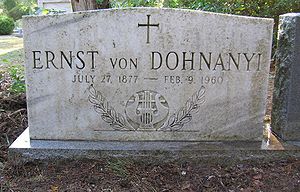Conducted by Matthias Bamert with the BBC Philharmonic.
| Grave site of Hungarian composer Ernst von Dohnanyi. This is the final resting place of Ernst von Dohnanyi (Ernő Dohnányi)at Roselawn Cemetary in Tallahassee, Florida, USA. (Photo credit: Wikipedia) |
II. Molto Adagio - 15:32
III. Scherzo - Presto - 28:27
IV. Intermezzo - Andante Poco Moto - 33:49
V. Finale: Introduzione: Molto sostenuto --Tema con variazioni: Allegro non troppo - 37:25
It was at this point, in 1900, at the age of twenty-three, that he felt ready to embark on his first symphony. Only three years earlier, he had graduated from the Budapest Academy, emerging as that institution's first internationally recognized success and keen to be seen as Hungary's leading young composer. The influences of both Liszt and Brahms were strong in his early works, combining the motivic workings of the one with the Classical formal preoccupations of the other.
In his First Symphony there is also something of Bruckner in the hushed D minor opening and the horn and trumpet theme that soon emerges, and, indeed, in the orchestral unisons that Dohnányi deploys at some of the dramatic climaxes. But the melancholy harmonies are his own, as is the generally rhapsodic flow of his musical ideas. That first horn/trumpet idea is gradually broken up into motifs and built back up again into a magnificent, fortissimo tutti statement, before the music subsides quickly into the second subject, a warmly flowing B major theme on the violas, accompanied by bassoons and lower strings. But even here, one of the nagging motifs from the first theme intervenes and the mood grows more martial, led by an angry dotted-rhythm idea. The second theme reappears on oboe and then in all its glory in the full orchestra. More development of all the material follows. There are several false starts to the recapitulation on the way back to the grandiose re-entry of the horn/trumpet theme on full orchestra, and the second subject now follows in a grand string unison, with the woodwind bringing the dotted-rhythm motif into line. A slower coda swells to one last attempt at the main theme and the movement ends in an unconquered D minor
The first of the Symphony's two slow movements opens with a solo for the cor anglais, a melancholy theme in A minor that is subjected to a diffuse variation treatment. It is here, perhaps, that Dohnányi's early mastery of the orchestra is most apparent (it was only his second orchestral work, after the First Piano Concerto): the central portion of the movement comprises a series of ever-more elaborate wind solos rhapsodizing on the contours of the cor anglais theme and intertwining with tremolo strings and harp in a lush mélée of sound. The middle movement is a fierce Scherzo in F major/minor, dominated by the insistent opening motif and characterized by frequent changes of metre, including series of bars in 5/4 time. The Intermezzo that follows could hardly be more of a contrast. The orchestra is reduced to strings, oboes and bassoons and the movement is effectively a miniature B major rhapsody for a solo viola.
The dramatic D minor opening of the Finale proclaims that the battle is not yet won. But after a short pause a gentler theme is introduced on the flutes that is shortly to become the subject of a set of variations. The form of this movement is very similar to that which Dohnányi would adopt some fifty years later in his Second Symphony with, in both cases a handful of variations followed by a fugue. Here, the theme is first presented in full on the strings, picked up by oboes and clarinets. For the first of the variations, the theme moves to the pizzicato cellos and basses; the second has the air of a fanfare, while the third is a more tranquil episode with the theme on cellos and clarinets; the fourth is presented by the brass like a stately chorale. The tempo and excitement gradually pick up and lead to the energetic fugue, its subject taken from the movement's introduction and ultimately derived from the horn and trumpet theme which opened the Symphony, now ending in a hard-won blaze of D major.











